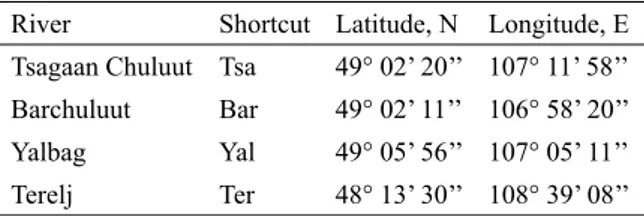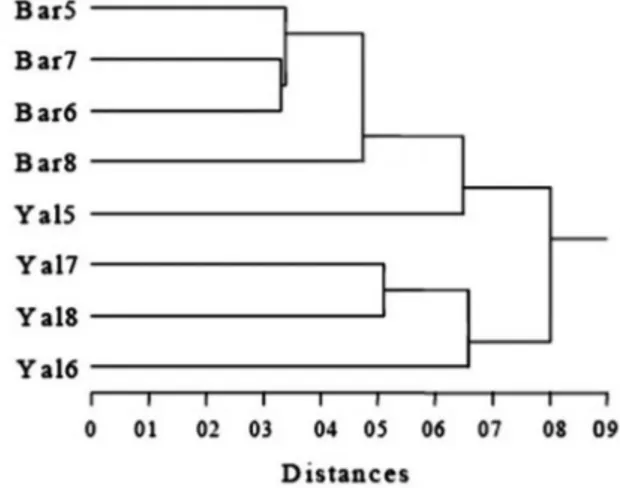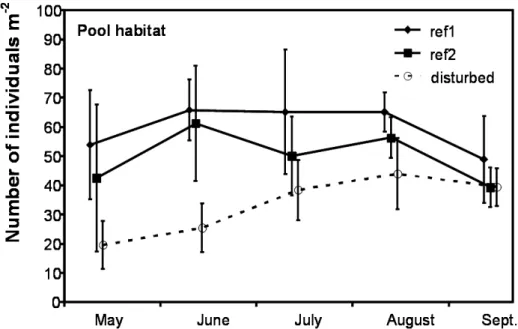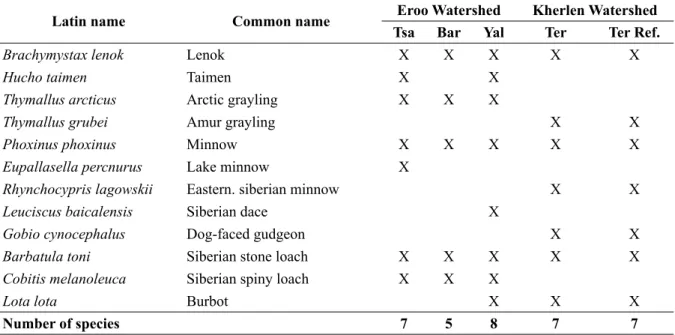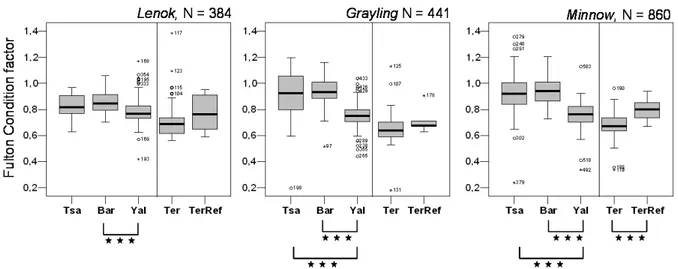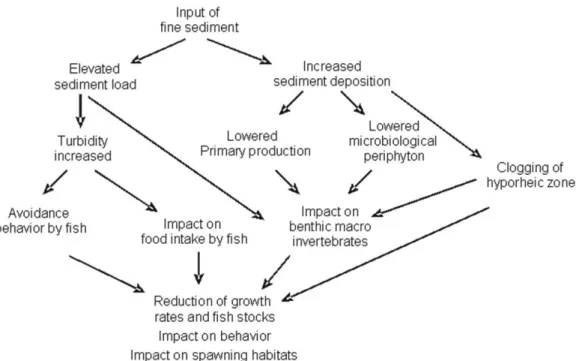41
Impacts of Open Placer Gold Mining on Aquatic Communities in Rivers
of the Khentii Mountains, North-East Mongolia
Daniel A. Krätz
1, Ralf B. Ibisch
2, Saulyegul Avylush
3, Ganganmurun Enkhbayar
3,
Soninkhishig Nergui
3and Dietrich Borchardt
21University of Kassel, Centre for Environmental Systems Research (CESR), Department for Integrated Water Resources Management, Kassel, Germany; e-mail: danielkraetz@gmx.de
2Helmholtz-Centre for Environmental Research-UFZ, Department Aquatic Ecosystem Analyses and Management, Magdeburg, Germany
3National University of Mongolia, Faculty of Biology, Ulaanbaatar, Mongolia
Abstract
Since the political change and due to high market prices for gold the mining sector has consid-erably grown in Mongolia and has become one of the most important economical sectors. With in-creasing mining activities the mining related environmental problems also increased, especially those, which are caused by open placer gold mining. Placer gold deposits are located in the alluvial sedi-ments of river ! oodplains and the exploitation of these deposits often induces severe impacts to river ecosystem and its different components. In this paper we describe the effects of open placer gold min-ing on diatoms, benthic invertebrates and " sh in four rivers in the north-east of Mongolia. Our " ndmin-ings are based on a comparative analysis of these biocoenotic groups in pristine and mining affected river sections, taking into account also abiotic habitat characteristics. Our analyses revealed that placer gold mining causes multiple stressors acting on different trophic levels. The biocoenotic groups under in-vestigation reacted differently against stressors, and we indenti" ed a wide range of direct and indirect effects. These " ndings are new for Mongolia and are essential to de" ne adapted and successful strate-gies for an ecologically based management and monitoring of open placer gold mining pressures and ecological impacts.
Key words: Turbidity, suspended sediments, clogging, river continuum, " sh fauna, macroinvertebrates,
dia-toms
Introduction
In North-East Mongolia both extremes exist: (1) large-scaled undisturbed and pristine land-scapes and (2) river ecosystems, which are faced with a rapidly growing mining industry with its diverse environmental impacts (World Bank, 2006). The majority of the gold deposits of this region are located in so called ´placer deposits´ in the alluvial sediments of the river ! oodplains. The exploitation of these placer deposits causes diverse environmental problems in! uencing the river-ecosystem in multiple ways (Farrington, 2000). For Mongolia placer gold mining is seen to be responsible for the entire loss or eventually long-lasting damage of at least 29 large-scaled river eco-systems, respectively parts of it (Mon-golian Ministry of Nature and Environment, 2003).
Worldwide, the effects of open placer gold
mining on aquatic ecosystems are well docu-mented. Numerous authors have reported on the effects for the ecosystem itself (Newcombe & MacDonald, 1991) or speci" c components, e.g. primary production (Van Nieuwenhuyse & La-Perriere, 1986), macroinvertebrates (Wagener & LaPerriere, 1985) or " sh (Pentz & Kostaschuk, 1999; McLeay et al., 1987). Although in Mon-golia mining is seen to be a major threat to river ecosystems and its biocoenoses (Grayson, 2003; Ocock et al., 2006), little is known about the site-speci" c impact and the scienti" c basis for target-ed regional management given the speci" c situa-tion for Mongolia.
The main focus of this study was, therefore, to comparatively analyze the biocoenoses in pris-tine and mining affected sites and to estimate the effects of open placer gold mining on different biocoenotic groups (diatoms, macroinvertebrates and " sh). Based on these analyses principles for an ecologically orientated monitoring and
agement of the open placer gold mining in Mon-golia are derived.
Study Area
Two study areas were chosen in the border area of the strictly protected area (SPA) Khan Khentii, which is located in the north-east of the capital city, Ulaanbaatar. The study areas had both features, river stretches which can be as-sumed to be pristine with negligible human
im-Fig. 1a). Along these stretches the natural bank structures and the riparian zone were predomi-nantly lost due to open placer mining activities which normally start with the removal of organ-ic top soil and the turning over of valley bottom sediments to the bedrock for subsequent process-ing to remove gold. In addition, minprocess-ing activities caused severe changes in the matter and sedi-ment balance downstream of the mined sites. In the study area the upstream part of the river Yal-bag, called Barchuluut and another con! uences of the river Eroo, called Tsagaan Chuluut served as a reference.
Our second study area was the river Terelj, which is part of the Kherlen watershed and is lo-cated south of the SPA Khan Khentii. The min-ing area is situated in the upper reaches of the river Terelj (see Fig. 1b) also in! uencing the middle and down reaches by high emissions of suspended sediments. We focused our studies to this area along a longitudinal transect of 40 km in length. We also studied one site upstream of the mining area and three tributaries of the river Terelj serving as reference sites. All study areas River Shortcut Latitude, N Longitude, E
Tsagaan Chuluut Tsa 49° 02’ 20’’ 107° 11’ 58’’ Barchuluut Bar 49° 02’ 11’’ 106° 58’ 20’’ Yalbag Yal 49° 05’ 56’’ 107° 05’ 11’’ Terelj Ter 48° 13’ 30’’ 108° 39’ 08’’
Table 1. Geographical location of study areas
pact, and others which are severely affected by open placer gold mining.
The Yalbag River is located in the western border area of the SPA Khan Khentii and it be-longs to the Eroo watershed (Table 1). At the river Yalbag mining activities were conducted in middle and down reaches of the watershed (see
Figure 1. Study area in the western- (a) and southern Khentii (b) with study sites (white circles) at pristine and affected stretches of the river.
a)
b)
belong to the biocoenotical region of the Epi- to Metarhithral (Jungwirth et al., 2003).
Materials and Methods
The effects of open placer gold mining on the biocoenosis were studied with regard to diatoms, macroinvertebrates and " sh. Field surveys for diatoms were conducted monthly during the ice-free periods in 2004 and 2005. Within the quali-tative sampling program samples from stones, " ne substrates and macrophytes were taken and
diatoms were later analyzed in the laboratory us-ing standard methods and equipment (Krammer & Lange-Bertalot, 1986-91).
aside. In plant habitats an area equal to the frame size was washed using hands to let the currency carry the macroinvertebrates into the Surber sam-pler held directly adjacent to the sampling site. The material in the sampler mesh was poured through two buckets and an analysis sieve of 500 µm, and was then transferred onto white plastic trays. The samples were sorted in the ! eld, put into glasses containing 80% ethanol and then transferred to the laboratory. In the laboratory organisms were sorted from organic matter and stored in 80% ethanol until they were identi! ed to the lowest taxonomic level possible, usually to genus.
The ! sh fauna was also sampled quantita-tively using electro-! shing gear (Hans Grassl GmbH, Germany; Type ELT 60). The ! sh were caught, determined and measured in length and weight. With the length and weight data the con-dition factor after Fulton (Ricker, 1975) was cal-culated and considered as ! tness indicator. Ad-ditionally to the quantitative sampling migratory patterns of ! sh were studied by installing weirs at several sites. Weirs were installed downstream and inside the mining area at the river Yalbag as well as at one by-pass channel, which spans parts of the mining area (see Figure 7). This study was performed during a two-week time period in spring 2006, whereas electro ! shing campaigns were carried out regularly from 2003 through 2006.
Results
Laboratory analyses identi! ed 62 diatom spe-cies belonging to 35 genera with no signi! cant differences in species and genera numbers be-tween pristine and mining affected sites. How-ever Canonical Correspondence Analyses (CCA) based on the taxa and the relative abundances pointed out differences between two groups of sites, and cluster analyses clearly separated the two groups (Fig. 2). Comparative analyses based on the ecological guilds revealed that the relative amount of mobile taxa (e.g. Cylindrotehca, Gy-rosygma, Navicula, Nitzschia and Surirella) were signi! cantly higher at affected sites, when com-pared to reference sites.
For macroinvertebrates the number of taxa (N) and total abundance of individuals (ind. m-2) were signi! cantly higher in pristine sites than in affected sites, especially in pool-habitats. At the
study sites in the Eroo watershed this pattern was signi! cant (t-test, p < 0.05) during spring season (May and June), and visible, but not signi! cant during the rest of the sampling season (see Fig. 3).
At the river Terelj the benthic invertebrate community was clearly different at sites down-stream of the mining area. Here the abundance of macroinvertebrates decreased from more than 8.000 ind./m² upstream the mining area to only a few individuals at the site located directly down-stream of the mining area (Fig. 4). Along the 40 km transect the benthic invertebrate abundances remained relatively low and reached maximum values of less than 2.000 ind./m². Regarding the habitat type, pool habitats seemed to be most af-fected, showing the lowest number of individuals when compared to rif" e and bank habitats.
The mining activities also in" uenced ben-thic invertebrate species composition. A non-metric, multi-dimensional scaling (NMDS) based on abundances showed that macro in-vertebrate communities differed signi! cantly between pristine and affected sites (ANOSIM signi! cance: < 0.001, see Figure 5). In Figure 5 the abiotic variables conductivity, pH, oxygen concentration, temperature and suspended sedi-ments were included in a second step by envi-ronmental ! tting. Differences between these pa-rameters were signi! cant between reference and downstream sites (Mann-Whitney test, p < 0.05) but seemed to be ecologically relevant only for suspended sediments.
For the ! sh fauna the results were somehow ambiguous. Based on the species community no differences were found between reference and disturbed sites (see Table 2). In the study area of the river Yalbag the number of species was actu-ally higher in disturbed sites than in the reference sites (8 compared to 7 and 5, respectively).
A similar pattern was found for the total abun-dances of ! sh at the river Yalbag, which were
signi! cantly higher (Mann-Whitney-Test, p< 0.05) downstream of the mining area. At the riv-er Triv-erelj no such pattriv-ern could be obsriv-erved. The analyses of the ! sh community showed clear dif-ferences between the sites (based on a NMDS). At the mining affected sites, non-sensitive spe-cies like siberian dace and siberian stone loach were dominant, whereas in reference sites they were rare or even missing. Signi! cant
differ-Figure 3. Abundance (ind. m-2) of macro invertebrates in reference sites (ref1 and ref2, respectively Barchu-luut and Tsagaan ChuBarchu-luut) and in disturbed sites (Yalbag) during the time period of May until September (Mean
± Standard Deviation).
Figure 5. Non-metric, multi-dimensional scaling based on macroinvertebrate relative abundances using Bray-Curtis dissimilarity. R = reference sites in River Barchuluut and River Tsagaan Chuluut (4 sites in total). S = sedi-ment impacted sites in River Yalbag (two sites). Continuous numbers refer to sampling dates. Abiotic variables and sampling dates were included by environmental ! tting.
Latin name Common name Eroo Watershed Kherlen Watershed
Tsa Bar Yal Ter Ter Ref.
Brachymystax lenok Lenok X X X X X
Hucho taimen Taimen X X
Thymallus arcticus Arctic grayling X X X
Thymallus grubei Amur grayling X X
Phoxinus phoxinus Minnow X X X X X
Eupallasella percnurus Lake minnow X
Rhynchocypris lagowskii Eastern. siberian minnow X X
Leuciscus baicalensis Siberian dace X
Gobio cynocephalus Dog-faced gudgeon X X
Barbatula toni Siberian stone loach X X X X X
Cobitis melanoleuca Siberian spiny loach X X X
Lota lota Burbot X X X
Number of species 7 5 8 7 7
Table 2. Fish species found at the study sites in the Eroo and the Kherlen watershed (Ter = River Terelj, Ter Ref. = Tributaries of the River Terelj).
ences were also found for the individual ! tness of some ! sh species (see Fig. 6). The Fulton con-dition factors for arctic grayling, lenok and min-now were found to be signi! cantly lower (Mann-Whitney-Test, p < 0,005) at the affected sites (Yal). At the river Terelj only minnow displayed
signi! cant differences with individuals being less corpulent at the affected sites (Ter).
area and in the by-pass channel (weir 1, 2 & 3a), whereas in the weir inside the mining area (weir 3b) these species were almost missing. Stone loach on the other hand was numerously caught in all weirs, whereas minnow was found almost exclusively in weir 3b.
Discussion
Based on the comparative analyses of impacted and reference sites our study showed that the biocoenotic groups reacted differently to the disturbances caused by open placer gold mining.
For diatoms we found a change in the community structure from non-mobile (af! xed) to rather mobile taxa, which could be caused by sedimentation of ! ne sediments (Passy, 2007). We assume that elevated loads of suspended sediments are likely to cause higher sedimentation rates. As a consequence benthic bio! lms get covered with sediment.
Mobile species may be able to respond to this environmental change and move to the sediment surfaces in order to get access to favorable light conditions, whereas immobile taxa get covered by sediment deposits and are likely to die off due to the lack of light. This ! nally causes an increase in the relative abundance of mobile species. Comparative studies showed similar results (Dickman et al., 2005 ), but these indirect effects have not been shown for gold mining areas.
In our study the macroinvertebrate communities showed direct reactions to the environmental changes downstream of the mining areas. Based on our analyses we conclude that elevated loads of suspended sediments are of major concern. Negative effects of increased suspended sediment loads are well known and have been numerously documented in literature (see review of Newcombe and MacDonald, 1991). Direct effects for example result from an increase of shear stress causing elevated
Figure 6. Fulton condition factors for lenok (B. lenok), arctic and amur grayling (Thymallus spp.) and minnow (Ph. phoxinus) at the reference sites Tsagaan Chuluut, Barchuluut and at the river Terelj (TerRef) and the affected sites Yalbag and Terelj.
drift rates of organisms (Berry et al., 2003) or clogging of respiratory organs. Indirect effects for macroinvertebrates result from lowered benthic bio! lm biomass and food quality due to light limitation (Van Nieuwenhuyse & LaPerriere, 1986, Ryan, 1991) and deposition of ! ne sediments. This results in a bottom-up control of benthic invertebrate biomass and abundance (Wagener & LaPerriere, 1985; Wood & Armitage, 1997; Fossati et al., 2001) and benthic invertebrates diversity (Quinn et al., 1992). Another relevant factor is the loss of intergravel space due to clogging processes, which were found to occur at the impacted sites at river Yalbag (Ibisch et al., 2007). Clogging processes reduce the availability of refugial habitats in the intergravel space, which is especially important during catastrophic events like " oods or temperature extremes in winter times.
For ! sh we found a negative effect of gold mining on the corpulence factors of selected species. Several aspects have to be taken into account in order to explain this contradictory ! nding. For some ! sh species it is well docu-mented, that turbidity and elevated sediment loads lower the ef! ciency of food intake, and thus lowers growth rates of ! sh (Lloyd et al., 1987; Rowe & Dean, 1998). Another factor can be seen in the bottom-up control of ! sh biomass by productivity of lower trophic levels. Reduced
macroinvertebrate biomass and abundances are likely to affect ! sh biomass and abundances and may at the end also reduce ! sh stocks (Harding & Boothroyd, 2004; Rowe & Dean, 1998). Our study also revealed effects of gold mining on the migratory behavior of ! sh and thus on the river continuum. Numerous authors have been described the impact of suspended sediment on the behavior of ! sh (Newcombe & MacDonald, 1991) with some studies also reporting the fact that ! sh do interrupt the migration further up-stream (McLeay et al., 1987). No direct effects of gold mining on ! sh species richness or abun-dance were found in this study. This is possible due to relatively low suspended sediment centrations at the studied river sections with con-centrations below 200 mg/l (Ibisch et al., 2007). Following the review of Newcombe & MacDon-ald (1991) these values can be ranked as margin-ally or moderately harmful, which might be an explanation for our ! ndings.
Clear effects on the other hand were de-tected for ! sh community structure, with habi-tat alterations assumed to be a major cause for these effects. Additionally, water temperatures in Yalbag river downstream the mining sites were signi! cantly elevated (1.92 ± 4,40°C upstream, versus 4.07 ± 6.73°C downstream, yearly average values based on continu-ous temperature measurements, Ibisch et al., 2007). This elevation in stream temperatures
are likely to cause changes in the ! sh commu-nity (Reeves et al., 1987), and may promote the dominance of siberian dace in our case. Major impacts on ! sh also result from clog-ging of the river bed (Ibisch et al., 2007) re-garding habitat quality and habitat availability in the hyporheic zone (see detailed discussion in Krätz, 2009).
Our analyses showed that open placer gold mining causes multiple stressors in riverine eco-systems. However, these stressors act on dif-ferent levels. Focusing only on the input of ! ne
sediments one realizes, that the observed effects are highly interlinked (see Fig. 8). Besides the input of ! ne sediments, there are other important disturbances caused by open placer gold min-ing related to the hydrological regime, chemical contaminants or loss of the natural riparian zone. These disturbances on the other hand each cause another cascade of effects, which are still barely understood and where future research still needs to be conducted.
In our study the biocoentic groups reacted dif-ferently to stressors and we indenti! ed a wide
Diatoms Macro invertebrates Fish
Number of species + + + + +
Species community + + + + + + + +
Abundance n.s. + + + +
Individual ! tness n.s. n.s. + +
Migration / Behavior + + n.s. + + +
Table 3. Effects of open placer gold mining on diatoms, macro invertebrates and ! sh in different categories (+++ = signi! cant negative effect; ++ = moderate negative effect; + = minor or no effect; n.s. = not speci! ed).
range of effects, both direct and indirect ones. The following table summarizes the results for diatoms, macroinvertebrates and ! sh. We classi-! ed the observed effects systematically in large, moderate or minor effects.
For the majority of open placer gold mines in Mongolia best management practices are not implemented (World Bank, 2006), and func-tional monitoring programs are not established by the of! cial administration. This is also true for the mining areas assessed in this study. This observation is in clear contrast to the results of numerous reports, which concentrated on min-ing and environmental issues (Farrmin-ington, 2000; Grayson, 2003; World Bank, 2006). Here the urgent need for targeted and effective manage-ment strategies and observation programs are emphasized. Our ! ndings contribute to better understand environmental effects of mining and may serve as a scienti! c basis for the formula-tion of adapted management and monitoring strategies for the Mongolian placer mining in-dustry.
Acknowledgement
This project was funded by the German Fed-eral Ministry of Science and Research (BMBF), Funding-ID 0330398.
References
Berry, W., Hill, B., Melzian, B. & Rubinstein, N., 2003. The Biological Effects of Suspended and Bedded Sediments (SABS) in Aquatic Systems: a Review, Internal report prepared by the U.S. Environmental Protection Agency, Of! ce of Research and Development.
Dickman, M. D., Peart, M. R. & Yim, W.W.-S., 2005. Benthic diatoms as indicators of stream sediment concentration in Hong Kong. Internationale Revue der gesamten Hydrobiologie, 90(4): 412– 421.
Farrington, J., 2000. Environmental problems of placer gold mining in the Zaamar Gold! eld, Mongolia. World Placer Journal, 1: 107-128. Fossati, O., Wasson, J.G., Hery, C., Salinas, G. &
Marin, R., 2001. Impact of sediment releases on water chemistry and macroinvertebrate communities in clear water Andean streams (Bolivia). Archiv für Hydrobiologie, 151(1): 33-50.
Grayson, R., 2003. Impacts of placer gold mining on the red book species of Mongolia.
World Placer Journal, 3.
Societies, Christchurch: NZ pp. 36.1-36.10. Ibisch, R.B., Krätz, D. & Borchardt, D., 2007.
Beein! usst die Kolmation des hyporheischen Interstitials den Temperaturhaushalt von
Flie"gewässern? In: Deutsche Gesellschaft für Limnologie. (DGL) (Editor), Tagungsbericht 2006. Dresden.
Jungwirth M. et al., 2003. Angewandte Fischökologie an Flie"gewässern. 1. Au! age, Wien, Facultas-Universitätsverlag.
Krätz, D., 2009. Ökologie der Fischbestände in Flie"gewässern des Khentii-Gebirges (Mongolei): Bestandsaufbau, Dynamik und Gefährdung durch den Gold-Tagebau., PhD thesis, University of Technology Dresden, 173 pp.
Krammer, K. & Lange-Bertalot, H. 1986-91. Sü"wasser! ora von Mitteleuropa, Bacillariophyceae. 2/1 Naviculaceae, 876 pp.; 2/2 Bacillariaceae, Epithemiaceae, Surirellaceae, 596 pp.; 2/3 Centrales, Fragilariaceae, Eunotiaceae, 576 pp.; 2/4 Achnanthaceae, 437 pp.; Gustav Fischer Verlag, Stuttgart.
Lloyd, D.S., Koenings, J.P. & La Perriere, J.D., 1987. Effects of turbidity in fresh waters of Alaska. North American Journal of Fisheries Management, 7: 18-33.
McLeay, D.J., Birtwell, B.F., Hartman, G.F. & Ennis, G.L., 1987. Responses of arctic grayling (Thymallus arcticus) to acute and prolonged exposure to Yukon placer mining sediment. Canadian Journal of Fisheries and Aquatic Sciences, 44: 658-673.
Mongolian Ministry of Nature and Environment, 2003. Annual Report.
Newcombe, C.P. & MacDonald, D.D., 1991. Effects of Suspended sediments on Aquatic Ecosystems. North American Journal of Fisheries Management, 11: 72-82.
Ocock, J. et al., 2006. Mongolian Red List of Fishes. Vol. 3, London.
Passy, S.I., 2007. Diatom ecological guilds display distinct and predictible behavior along nutrient and disturbance gradients in running waters. Aquatic Botany, 86(2): 171-178. Pentz, S.B. & Kostaschuk, R.A., 1999. Effect
of placer mining on suspended sediment in reaches of sensitive # sh habitat.
Environmental Geology, 37(1-2): 78-89. Quinn, J.M., Davies-Colley, R.J., Hickey, C.W.,
Vickers, M.L. & Ryan, P.A., 1992. Effect
of clay discharges on streams - 2 Benthic invertebrates. Hydrobiologia, 248: 235–247. Reeves, G.H., Everest, F.H. & Hall, J.D.,
1987. Interaction between redside shiner (Richarsonius balteatus) and the steelhead trout (Salmo gairdneri) in western Oregon: the in! uence of water temperature. Can. J. Fisheries and Aquatic Sciences, 44: 1603-1613.
Ricker, W.E., 1975. Computation and
interpretation of biological statistics of # sh populations. Bulletin of the Fisheries Research Board of Canada, 191: 1 - 382. Rowe, D.K. & Dean, T.L., 1998. Effects of
turbidity on the feeding ability of the juvenile migrant stage of six New Zealand freshwater # sh species. New Zealand Journal of Marine and Freshwater Research, 32: 21-30.
Ryan, P.A., 1991. Environmental effects of sediment on New Zealand streams, a review. New Zealand Journal of Marine and Freshwater Research, 25: 207–221.
Van Nieuwenhuyse, E.E. & LaPerriere, J.D., 1986. Effects of placer gold mining on primary production in subarctic streams of Alaska. Water Resources Bulletin, 22: 91-99. Wagener, S.M. & LaPerriere, J.D., 1985. Effects
of placer mining on invertebrate communities of interior Alaska streams. Freshwater Invertebrate Biology, 4: 208–214.
Wood, P.J. & Armitage, P.D., 1997. Biological effects of # ne sediment in the lotic environment. Environmental Management, 21(2): 203-217.
World Bank, 2006. Mongolia: A review of environmental and social impacts in the mining sector. World Bank.
••••••••
!"#$%$&'(, &))*%+ -/122&2+ 3)4!/6!7))* 7!$1))6!6 *#8&#+ *9/99//%+1 ):))/6!1.
;%6 !*!7)) 91))/!/6 2/&*< %/ =#4##* #46*< *9/99//%+1 >#*1#/ #4*< :))* 7#+6 7!$1%+* 694?9* 1#/6 &247$2* :212$, @4##/<* $!!4*A4AA1)+&!*, 827%A4& :2(1%+* B%=!!* 6!!4 #47#+/$#* C(. DA62/1221 7)*%+ )+/ 2B%//2122*6 3212 94&$9* 3#/#* AA/ AA472+* #/3#4/#/& 3)7%+ 1#/<* 7!$1))6 6!7 3%#8'*#:<* 3)/1))6%+1, (9* #4E*< 23%#&%" 7)E%* :)+/%+1 72412/:2* ):!B 724F8AA/$2* 32+6/224 6)1*!* ):$!*. ;%6*%+ $A62/122*< )4 6)*6 2/&*< %/ =#4##*
#46*< #/3#4/#/& *F A$2* #4E*< %6!= &!B!!/%+* -/122&2+ &)?=*))6!6 7!6 7!6!* *9/99/9/ ):))/6!1 3#/#7<1 &##$#* C(. DA62/122*6 72(4216$2* 3%#8'*#:<* 3)/1))6 !61!!4 *9/99/9/))6!6 -/122&2+ 32+6/224 724%A )+/6!/ ):))/$!* 32 9419* 824 7)4!! 3)7%+ =AA6 3#/#* =AA6 3A$ *9/99//%+1 #47#+/$#* 3#/*#. G61!!4 $A62/122*< )4 6)* *F >#*1#/ #4*< 7A?F6 =%*!/!1 391996 !"#/#1%6 )*6!$/!$!* ('*'B('*&%+1 -?AA/27
:9? :#7%$&#+ $&42&'1%+1 3#/#?$4AA/27,
2/& #/3#4/#/&##$ ):))/!7 *9/99//%+*
(#*%%*1 7%+7!6 :2+/=1)+ EA72/ C(.
